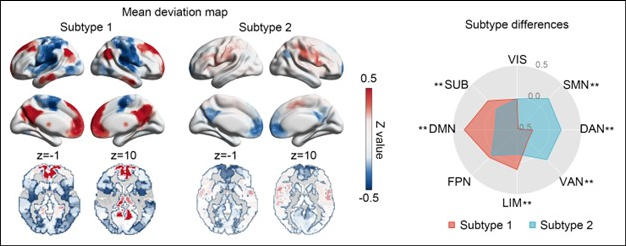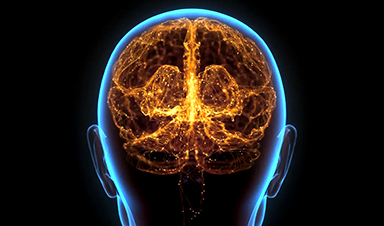New research reveals that functional connectivity can distinguish between various disease subtypes.
Not only is major depressive disorder (MDD) one of the most prevalent mental health conditions, affecting more than 8% of the U.S. population, but it also manifests in diverse ways among individuals. Although recent research has made progress in understanding the neurological foundations of various depression subtypes, thereby paving the way for improved treatments, there is still much to explore. Now, a new study in Biological Psychiatry, published by Elsevier, identifies multiple subtypes of MDD using brain imaging.
John Krystal, MD, Editor of Biological Psychiatry, said of the work, "We have long known that disorders like major depressive disorder are highly heterogeneous. This study in a large sample of depressed patients provides leads that can be pursued in subtyping depression on the basis of functional magnetic resonance imaging (fMRI) tests that measure the degree of coordination across brain regions, also known as 'functional connectivity.'"
The researchers used resting-state fMRI collected at multiple clinical sites from a large cohort of more than 1,000 MDD patients and over 1,000 healthy controls (HC). The study used the so-called normative model, which uses data from a large reference population to quantify individual deviations, much like the growth charts used by pediatricians. The researchers examined the functional connectivity among brain regions and mapped individual functional deviations in the MDD patients compared to this normative prediction across the lifespan.

Brain imaging maps and a functional deviation map of the two depression subtypes across brain regions. Credit: Biological Psychiatry
Senior author Mingrui Xia, PhD, from Beijing Normal University, said, "This approach led to the identification of two reproducible neurophysiological subtypes exhibiting distinct deviation patterns, depressive item scores, and longitudinal treatment predictability."
One subtype of patients showed severe positive deviations – indicating increased brain connectivity – in the default mode network, limbic, and subcortical areas, and negative deviations in the sensorimotor and attention areas. The second subtype of patients featured a milder and opposite pattern of deviation, highlighting the heterogeneity of depression at the neurophysiological level. The authors speculate that the altered activity could be related to the tendency to ruminate in people with MDD.
The work is particularly exciting in that it moves the field toward finding biomarkers, or biological markers, of depression, which currently relies on patient-reported clinical symptoms for diagnosis, treatment, and prognostics. Biomarkers could offer a way to improve all these aspects of treatment for MDD.
Dr. Xia went on to say, "These findings shed light on the diverse neurobiological mechanisms from a connectomics perspective underlying the complex clinical heterogeneity observed in individuals with depression. The implications of this research are far-reaching, providing valuable insights into the development of imaging-based candidate biomarkers. These biomarkers have the potential to guide future precise diagnostic and treatment strategies tailored to each patient's specific neurophysiological subtype."
Dr. Xia noted, "By embracing the concept of neurophysiological subtypes, we can potentially revolutionize the field of mental health by enabling clinicians to personalize treatments based on an individual's unique connectome characteristics. This approach opens up new avenues for precision medicine and holds the promise of improving therapeutic interventions for depression."
Reference: "Mapping Neurophysiological Subtypes of Major Depressive Disorder Using Normative Models of the Functional Connectome" by Xiaoyi Sun, Jinrong Sun, Xiaowen Lu, Qiangli Dong, Liang Zhang, Wenxu Wang, Jin Liu, Qing Ma, Xiaoqin Wang, Dongtao Wei, Yuan Chen, Bangshan Liu, Chu-Chung Huang, Yanting Zheng, Yankun Wu, Taolin Chen, Yuqi Cheng, Xiufeng Xu, Qiyong Gong, Tianmei Si and Mingrui Xia, 7 June 2023, Biological Psychiatry.
DOI: 10.1016/j.biopsych.2023.05.021
News
Current Heart Health Guidelines Are Failing To Catch a Deadly Genetic Killer
New research reveals that standard screening misses most people with a common inherited cholesterol disorder. A Mayo Clinic study reports that current genetic screening guidelines overlook most people who have familial hypercholesterolemia, an inherited disorder that [...]
Scientists Identify the Evolutionary “Purpose” of Consciousness
Summary: Researchers at Ruhr University Bochum explore why consciousness evolved and why different species developed it in distinct ways. By comparing humans with birds, they show that complex awareness may arise through different neural architectures yet [...]
Novel mRNA therapy curbs antibiotic-resistant infections in preclinical lung models
Researchers at the Icahn School of Medicine at Mount Sinai and collaborators have reported early success with a novel mRNA-based therapy designed to combat antibiotic-resistant bacteria. The findings, published in Nature Biotechnology, show that in [...]
New skin-permeable polymer delivers insulin without needles
A breakthrough zwitterionic polymer slips through the skin’s toughest barriers, carrying insulin deep into tissue and normalizing blood sugar, offering patients a painless alternative to daily injections. A recent study published in the journal Nature examines [...]
Multifunctional Nanogels: A Breakthrough in Antibacterial Strategies
Antibiotic resistance is a growing concern - from human health to crop survival. A new study successfully uses nanogels to target and almost entirely inhibit the bacteria P. Aeruginosa. Recently published in Angewandte Chemie, the study [...]
Nanoflowers rejuvenate old and damaged human cells by replacing their mitochondria
Biomedical researchers at Texas A&M University may have discovered a way to stop or even reverse the decline of cellular energy production—a finding that could have revolutionary effects across medicine. Dr. Akhilesh K. Gaharwar [...]
The Stunning New Push to Protect the Invisible 99% of Life
Scientists worldwide have joined forces to build the first-ever roadmap for conserving Earth’s vast invisible majority—microbes. Their new IUCN Specialist Group reframes conservation by elevating microbial life to the same urgency as plants and [...]
Scientists Find a Way to Help the Brain Clear Alzheimer’s Plaques Naturally
Scientists have discovered that the brain may have a built-in way to fight Alzheimer’s. By activating a protein called Sox9, researchers were able to switch on star-shaped brain cells known as astrocytes and turn them into [...]
Vision can be rebooted in adults with amblyopia, study suggests
Temporarily anesthetizing the retina briefly reverts the activity of the visual system to that observed in early development and enables growth of responses to the amblyopic eye, new research shows. In the common vision [...]
Ultrasound-activated Nanoparticles Kill Liver Cancer and Activate Immune System
A new ultrasound-guided nanotherapy wipes out liver tumors while training the immune system to keep them from coming back. The study, published in Nano Today, introduces a biodegradable nanoparticle system that combines sonodynamic therapy and cell [...]
Magnetic nanoparticles that successfully navigate complex blood vessels may be ready for clinical trials
Every year, 12 million people worldwide suffer a stroke; many die or are permanently impaired. Currently, drugs are administered to dissolve the thrombus that blocks the blood vessel. These drugs spread throughout the entire [...]
Reviving Exhausted T Cells Sparks Powerful Cancer Tumor Elimination
Scientists have discovered how tumors secretly drain the energy from T cells—the immune system’s main cancer fighters—and how blocking that process can bring them back to life. The team found that cancer cells use [...]
Very low LDL-cholesterol correlates to fewer heart problems after stroke
Brigham and Women's Hospital's TIMI Study Group reports that in patients with prior ischemic stroke, very low achieved LDL-cholesterol correlated with fewer major adverse cardiovascular events and fewer recurrent strokes, without an apparent increase [...]
“Great Unified Microscope” Reveals Hidden Micro and Nano Worlds Inside Living Cells
University of Tokyo researchers have created a powerful new microscope that captures both forward- and back-scattered light at once, letting scientists see everything from large cell structures to tiny nanoscale particles in a single shot. Researchers [...]
Breakthrough Alzheimer’s Drug Has a Hidden Problem
Researchers in Japan found that although the Alzheimer’s drug lecanemab successfully removes amyloid plaques from the brain, it does not restore the brain’s waste-clearing system within the first few months of treatment. The study suggests that [...]
Concerning New Research Reveals Colon Cancer Is Skyrocketing in Adults Under 50
Colorectal cancer is striking younger adults at alarming rates, driven by lifestyle and genetic factors. Colorectal cancer (CRC) develops when abnormal cells grow uncontrollably in the colon or rectum, forming tumors that can eventually [...]





















